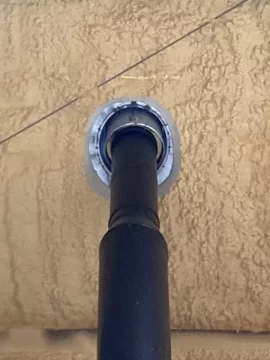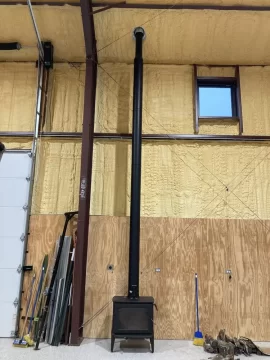Hi, I’m a first time wood stove owner and this is the first time for me to post here. I live in a 40’x 60’x20’ barndominium with at 6/12 roof pitch where the living area is on the mezzanine level that spans 800 sq ft. The entire ground level is shop area, but 1600 sq ft of the shop is the area that doesn’t have a mezzanine, so from the concrete slab going vertically goes straight to the roof (standing seam). The building is 100% metal, except for the mudroom interior walls, stairs, interior walls of the mezzanine and plywood walls that runs along the first 8’ of the exterior walls on the inside of the shop. The building is 100% spray foam insulated (open cell on walls that are not exposed and closed cell on exposed walls and ceiling (which is the underside of the steel roof).
I am in process of having a Hearthstone Green Mountain 80 installed in the shop area alongside one of the 60’ side walls. My installer connected 8" single wall stove pipe to the stove collar and then transitioned to 6" double wall insulated chimney pipe that goes through a larger diameter sleeve (pardon if I’m using the wrong terminology) which both extend up through the ceiling and roof. The chimney stack is ~ 7ft and will be supported by braces on the outside. As I was observing the transition through the ceiling and roof, I asked my installer if something else was supposed to be installed before the stove pipe transitions to chimney pipe and he said that normally a ceiling support box is placed there but it isn’t required. Is that true? If there are any people who are experts in this matter, I would welcome your thoughts on the upside and downside of not having one installed. Also, transitioning from 8" stove pipe to 6" double wall insulated chimney pipe--any thoughts would be appreciated. Many thanks.
I am in process of having a Hearthstone Green Mountain 80 installed in the shop area alongside one of the 60’ side walls. My installer connected 8" single wall stove pipe to the stove collar and then transitioned to 6" double wall insulated chimney pipe that goes through a larger diameter sleeve (pardon if I’m using the wrong terminology) which both extend up through the ceiling and roof. The chimney stack is ~ 7ft and will be supported by braces on the outside. As I was observing the transition through the ceiling and roof, I asked my installer if something else was supposed to be installed before the stove pipe transitions to chimney pipe and he said that normally a ceiling support box is placed there but it isn’t required. Is that true? If there are any people who are experts in this matter, I would welcome your thoughts on the upside and downside of not having one installed. Also, transitioning from 8" stove pipe to 6" double wall insulated chimney pipe--any thoughts would be appreciated. Many thanks.



